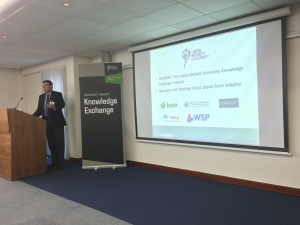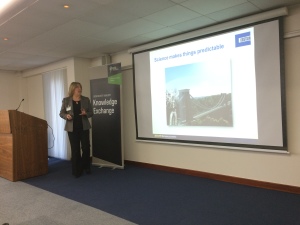A great turnout of construction professionals gathered at Addleshaw Goddard LLP in Leeds on 29th October for our second CEYH event of autumn focussing on SME excellence in two current hot topics; SME adoption of BIM & Applied Behavioural Science in Health & Safety. CEYH is the Yorkshire & Humber regional hub for Constructing Excellence, committed to providing a structured programme of events sharing knowledge, case studies and best practice which respond to the wider needs of the industry.
Our chair for Wednesday’s event was James Gill, BIM technician at Cubicle Centre. Cubicle Centre were the deserving recipients of the SME & Best of the Best awards at this year’s CEYH awards for their determination to become one of the first “bim ready” manufacturers in the UK and the increase business being so has brought them.
Our first speaker for the event was Duncan Reed, Digital Construction Process Manager at Tekla UK & ThinkBIM ambassador, who presented on the CITB funded BIM training that ThinkBIM has been delivering around the region to SMEs. He started by highlighting the issue that at present we have no real indication of BIM level 2 adoption in the UK, pointing out that the NBS National BIM report attracts around 1300 respondents, a tiny percentage of the estimated 2million people who work in the construction industry. The CITB funded training delivered by ThinkBIM goes some way to addressing this with the sessions highlighting key issues faced by SMEs & identifying solutions to overcome them. So far ThinkBIM has delivered 26 workshops over 117 companies to 359 delegates.
As well as outlining the aims of the CITB sessions, i.e. what is BIM? what tools are available e.t.c. pointing out that not all BIM software is new software (even excel is a useful BIM tool!), Duncan also went on to discuss some of the perceived barriers to BIM that attendees at the training sessions had raised and gave examples of how companies had overcome them, using two recent case studies, Premier Interlink & F Parkinson. At this point Duncan also mentioned the TSB Innovate initiative who award funding to small businesses to help them implement new technologies within their businesses. Further details can be found on the Innovate website here . Both Premier Interlink & F Parkinson have made use of the scheme receiving £5000 vouchers to help implement BIM throughout their operations with ThinkBIM’s advice.
Duncan concluded his presentation with some key tips on how organisations can start with BIM, the most important one being that companies have to decide a BIM strategy & objective for their own organisation first i.e. you can’t do someone else’s BIM. Once a strategy has been defined you are then in a position to look at what you need to make it happen and take it from there.
Following that we welcomed Claire Fryer, Senior Behavioural Management Consultant at Costain who presented on delivering behavioural health & safety training using accelerated learning techniques. Claire outlined some of the principles behind the science using some interesting examples from our everyday behaviours. Her example of how we alter our driving dependent on whether there is police car around certainly resonated with some members of our audience! Claire went on to describe the “Antecedents – Behaviours – Consequences” behavioural model used by Costain and how it is our understanding of the consequences which impact on our behaviours.
Claire then went on to illustrate some real examples of putting the model into practice; one particular case study being strategies taken to overcome a high percentage of slips, trips and falls recorded on a project. Some other key points she raised included the importance of focusing on one small problem to fix at a time, gathering specific data (using observation & the ABC model outlined above) and the importance of communication with workers i.e. asking them what they need in order to be able to adhere to health & safety principles and then working jointly towards it.
Claire concluded the presentation by outlining how there is huge scope for businesses to benefit from applied behavioural science throughout their entire operations, not just health & safety. It can be used to improve quality performance, delivery performance, even improving the processing of invoices. As long as you can understand why people behave the way they do within their working environments, then you can begin to use behavioural techniques to modify them. Claire’s final point was to reiterate that we shouldn’t just rely on email to get people to do what we want, we need to get out, talk to people and understand the consequences which drive behaviour, before we try to change it.
Following Claire’s presentation, the assembled audience were invited to ask questions, a summary of which are outlined below:
Are there any other alternate sources of funding for BIM training outside the CITB?
Duncan Reed (DR) TSB Innovation Vouchers are available to anybody. ThinkBIM can help organisations with their submissions for funding. Contact Claire on c.bowles@leedsbeckett.ac.uk to find out more.
What are the examples of how you have resolved some of the issues with getting clients involved in the model?
(DR) Involving the end users to make sure they are engaged in the design process so they can visualise the space they will be working in i.e. teachers & their classrooms.
Has ThinkBIM done anything with professional associations as well as companies direct?
We would like the professional bodies . We do find trade associations are doing a lot of work, providing advice, support & courses to help educate their member on BIM and how they can develop it within their businesses. We would like to see the same level of interest from the professional bodies which would ultimately then ensure it is included in university courses.
Duncan what are the key consequences of not doing in BIM? Thinking about the ABC model Claire talked about in terms of behavioural science & culture change?
(DF) The government’s 2025 construction strategy asks for massive improvements throughout the operation in costs efficiencies, health & safety standards e.t.c. Not doing BIM would make it very hard for companies to meet this target.
For Costain, how do you deal with the SME supply chain that come on site?
(CF) Many of our supply chain join our Supply Chain Academy where they have an introductory session on the principles involved. We also involve them early in projects, bringing them on to site, inviting them into meetings and training sessions so they can work on any arising issues with the existing team, and this is working really well.





Leave a Reply